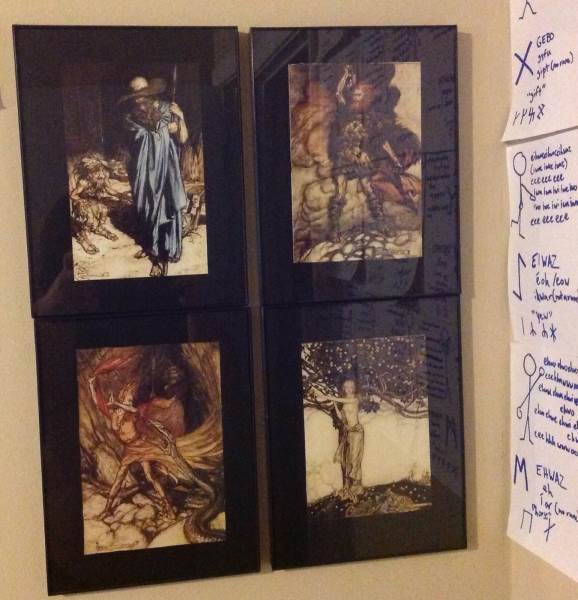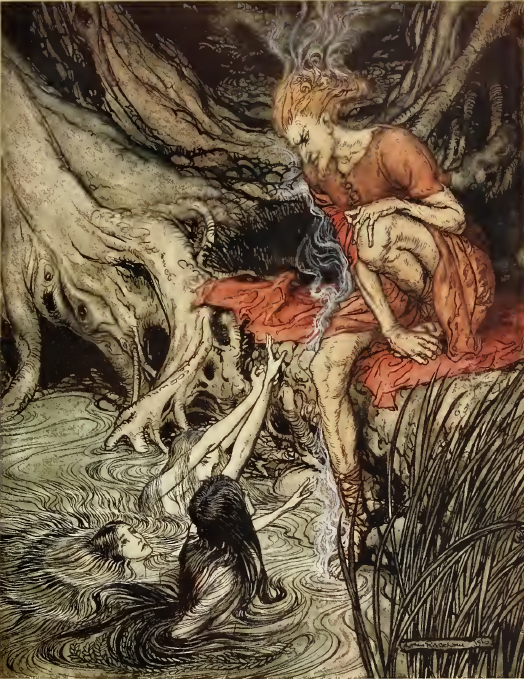
Four Arthur Rackham portraits. Clockwise from top right: Donner, Freia, Loge and Wotan meeting Alberich, and Wotan the Wanderer meeting Mime.
Also pictured: my runic yoga cheat sheets. Don’t judge me.
I come from carpenters. I’m not sure I would call it a family profession – more like the results of a long line of bull-headed men who couldn’t stand more than a few years of answering to a boss. Eventually, we all quit or got fired, picked up some tools, and starting putting up fences and building porches. We’ve never been the type to get certifications. My grandfather, even now, prefers to conduct as much of his business as possible in cash, a habit developed over decades of being paid under the table.
I am not a carpenter, now; in fact, when I was a teenager, first coming to terms with the kind of person I am, I would have nightmares about it. I would dream of waking up in my forties with a ruined back and a tapestry of scars woven across my forearms, the artistry of errant nails and utility knives. Even now, ten years out from the last time I spent a summer working with my grandfather as he hung gutters and tuck pointed a house, I sometimes wonder if this PHD I’m working on is just another way of running away from carpentry.
But there’s when it comes to driving nails, there is something in my blood, something in the musical collision of metal and drywall. I don’t do it often, but when I do, it’s holy. It’s no wonder that my god’s symbol is a hammer.
Today I am driving nails into the wall of my bedroom for picture frames. I eyeball everything. I don’t mind making crooked things: it’s a reminder of the human effort involved. To look at a row of pictures that are slightly off is to know that they are the work of human hands. (Writing, with all its inescapable errors and not-quite-right words, is much the same.)
The pictures are part of my altar area, which I am rebuilding yet again, despite having only put the altar up for the first time in this house a few months ago. My roommate found a wonderfully ugly old metal desk at the university surplus auction – or, more precisely, in the pile of things more valuable as scrap metal than as furniture – and so the end-table I had been using for a desk suddenly became available for better purposes. It’s just the right size for an altar – enough room to hold a variety of tools and statues without being too cluttered. It’s much better suited for this than for being a work desk – it barely held the monitor and a keyboard, much less the stacks of papers and overdue library books an English student tends to attract.
I took the pictures from an art book of Arthur Rackham’s illustrations of Wagner’s Der Ring des Nibelungen. I cut them out with an X-Acto knife and a cutting board; having no straight-edges available, I cut free hand, leaving a slightly curving edge to most of the pictures. (But then, what’s the problem with a crooked picture in a crooked frame?) I hung up four of the plates – Wotan, Donner, Freia, and Loge — to watch over my altar. I can see them from my bed when I wake up: four portraits of a mythic world, a world nobody else has ever conceived in quite the way Rackham did.
Arthur Rackham was no heathen, of course; he was mainly an illustrator of children’s books, though he felt his illustrations to the Ring cycle were “not well suited for those lucky people who haven’t yet finished the delightful adventure of growing up.” Rackham considered his Ring illustrations to be among his masterpieces, but then, he created many masterpieces. If his drawings of Wotan and Brunhilde held any special place in his heart, it was because of the reverence attached to Wagner’s operas, not because he personally believed in the Aesir.
But I do. When I look at Rackham’s Freia, or Donner, or especially Loge, I see Freyja and Thor and Loki. I feel this way even though Rackham did not. I am cognizant of the disconnect between the intentions of the artist and my use of his art; I am even more cognizant of the fact that these drawings are many steps removed from the “truth” of these deities, filtered as they are through Snorri Sturluson and the other Eddic writers, through Wagner’s appropriation and reinvention of the Eddas, through Rackham’s interpretation of Wagner.

Loge and the Rhinemaidens, Arthur Rackham.
In one picture – perhaps my favorite in the cycle – Loge sits at the edge of a pond, listening to the lament of the maidens of the Rhine for their lost treasure. Steam issues from all over Loge’s body; the water of the pond hisses into vapor at his touch. That’s because Loge, in the Ring, is a fire god, an assumption made based on how closely the words Loki and Loge resemble one another. But as any sufficiently pedantic heathen will tell you, there’s no evidence that Loki was ever considered connected to fire; it’s an accident, a deceitful homonym. Yet Loge’s association with fire is essential to the operas, such that the two most famous scenes, the endings of Die Walkure and Gotterdammerung, rely on Loge’s flames.
I know this, but still, when I look at Rackham’s pictures, I see my gods looking back. That may not have been what Rackham intended, but it is what I find. I cannot divorce the two.
This weekend, I will be going to see Thor: The Dark World with my fiancée. It’s our seventh anniversary, and we are dorks, so this is the kind of movie we are apt to see on such an occasion. I will be going into it as someone who grew up reading Marvel Comics, who still spends an unhealthy amount of money on them every month. But I will also be going into the theater as a heathen, as someone who wears a Thor’s hammer around his neck. As someone who, when he finds an excuse to pick up a hammer, immediately thinks of Mjolnir, and the labors of the god who wields it. If Rackham’s Donner is a distorted replica of the “real” Thor, then Marvel’s Thor is that replica run through about twelve generations of Xerox. But I can’t pretend it won’t have meaning to me. We are surrounded by portraits of our myths created by artists who do not believe as we do.
I do not know what they find in their work, but I find holiness – perhaps removed, perhaps distorted, but holy, still. Perhaps that is not what Rackham intended. I am certain it is not what Chris Hemsworth intends. But when I see a Rackham illustration, or hear a Wagner theme, or even shudder under the assault of a Marvel action scene… I see my gods in them. They are my contribution to the work.
When the pictures are finally hung, I note the imperfections. The portrait of the Wanderer sits slightly higher than the others. I have to adjust the pictures several times to fake the appearance of symmetry, even though that’s a futile task. I look at them and see the gods’ work, and Wagner’s work, and Rackham’s, and mine.
Work is holy. Carpenters know this.
The Wild Hunt is not responsible for links to external content.
To join a conversation on this post:
Visit our The Wild Hunt subreddit! Point your favorite browser to https://www.reddit.com/r/The_Wild_Hunt_News/, then click “JOIN”. Make sure to click the bell, too, to be notified of new articles posted to our subreddit.

Marvelous.
I should also note: this post marks my one year anniversary of writing here at the Wild Hunt. My deep thanks to Jason and everyone else here.
I know what you mean about the movie. I saw the first Thor in theaters, and though little resemblance was to be had historically, there was a resonance. Keep up the good work, and enjoy the movie for those of us who can’t make it opening weekend!
I also heard a bit of a chuckle from a certain son of Wodin as I watched.
I really dislike the Marvel movies. I say that as a Heathen, as a comic geek and as a movie fan.
I feel obligated to enjoy the Thor movies. XD (corny as the first one was)
I honestly liked the Avengers, warts and all.
I only watch them for Tom Hiddleston’s take on Marvel’s Loki. Everything else just pisses me off.
I saw Dark World and mostly liked it, Leoht. We will have to disagree on this.
I get that a lot.
I’m an artist and I felt that maybe you would be interested to know that even though an artist does not hold to the beliefs in the subject matter that they create in, there is always the Muse (and we all believe in that) that takes hold of our minds and hands and connects us to some misty cosmic oneness as we create, especially when it comes to things pertaining to the spirit worlds. Most artists would agree that something mystical is happening while our imagination is manifested in our chosen medium. And that is why I think you can feel something of the actual Gods/Goddesses in Rackham’s paintings. Most of the time when I’m painting I feel like I’m just a vehicle and am usually astounded by the finished product. There is something more at work than just my talent. And the same goes for any of the arts including movie making. I believe that’s why we can feel some semblance of the original inspiration in things like the movie Thor and Rackham’s paintings. The artist has put a bit of the God’s spirit into the creation even if that wasn’t their intent. That’s how the Muse works because after all, the Muse is also one of the Gods.
Thanks for writing this! Arthur Rackham and other artists from his era have something magical.I’m planning an exhibition on fairy tale artists in the Netherlands next year. I know it’s the other side of the world, but if you’re interested you can always send me a message so I can keep you up to date
Your welcome!
There’s a reason that most of us faerie artists emulate Arthur Rackham and his contemporaries. There is definitely something magical going on with them.
Yes, that is the other side of the world and I don’t travel. But if you’re interested I am a faerie artist and have a couple of websites where I sell my stuff. Hope it’s ok to post them here:
http://carrie-viscome-skinner.artistwebsites.com (fine art)
http://www.etsy.com/shop/faeriearthart (faerie houses, wings, and other things and a new line of clothing I’m just starting up.)
Hope you’ll check it out and good luck with your exhibition!
Thanks, Yvonne. Hey, send us a message when it gets closer, eh? I’m not Jason, of course, so no promises, but it might be up our alley for a story.
Thank you for this, Eric. I’m ashamed to say I was not familiar with Rackham but his work is right up my alley. Thank you for introducing me.